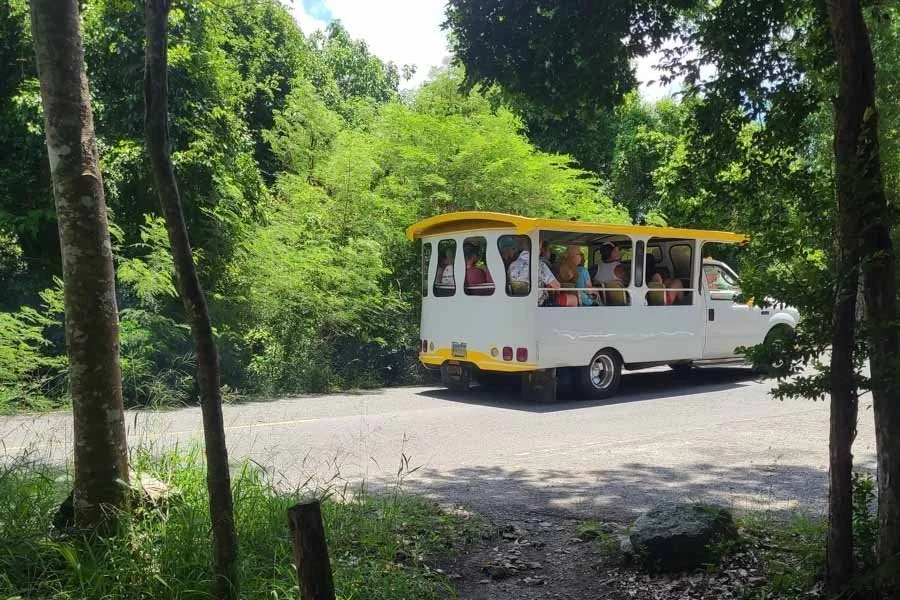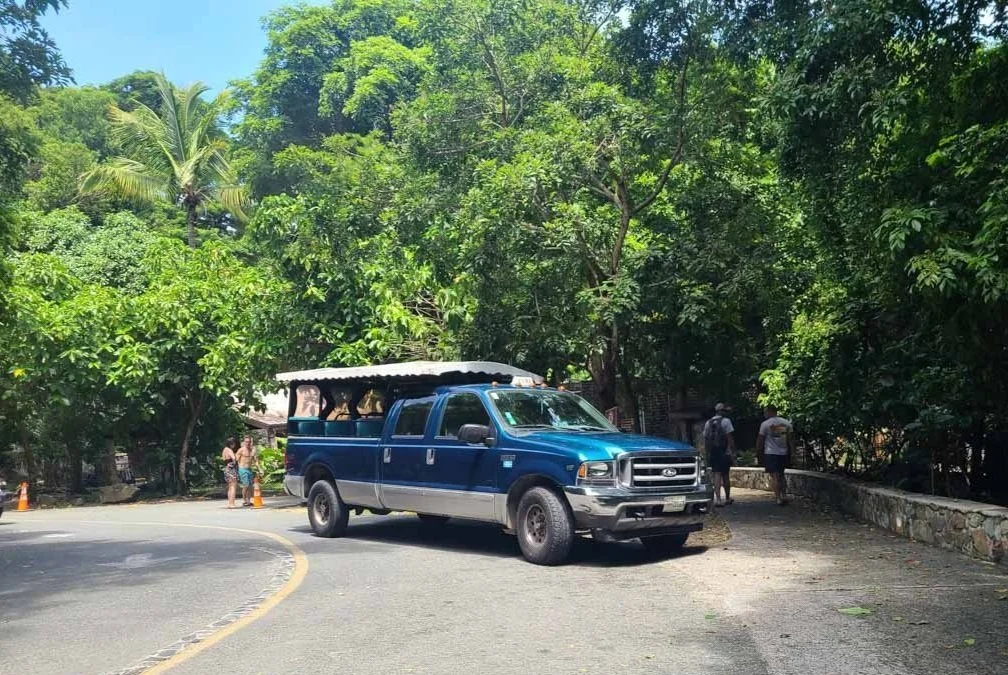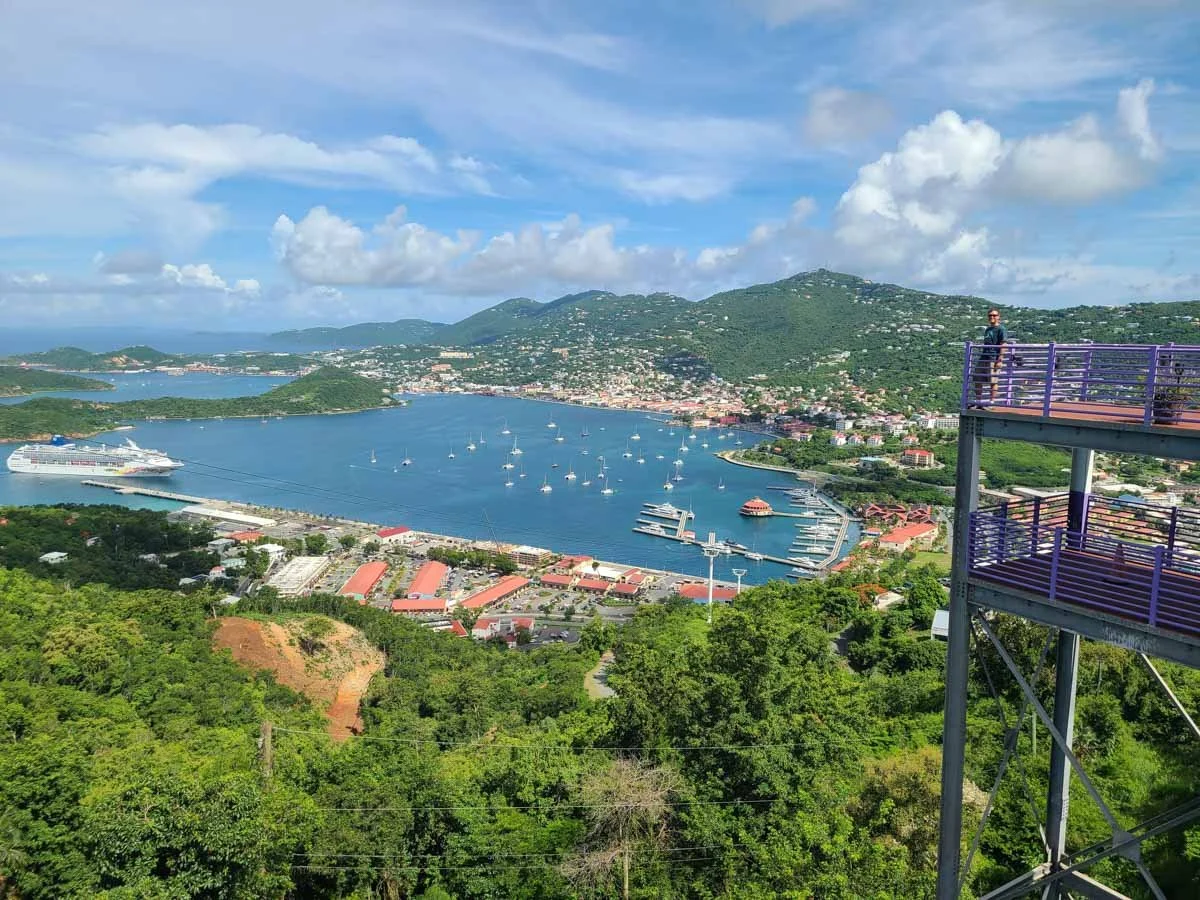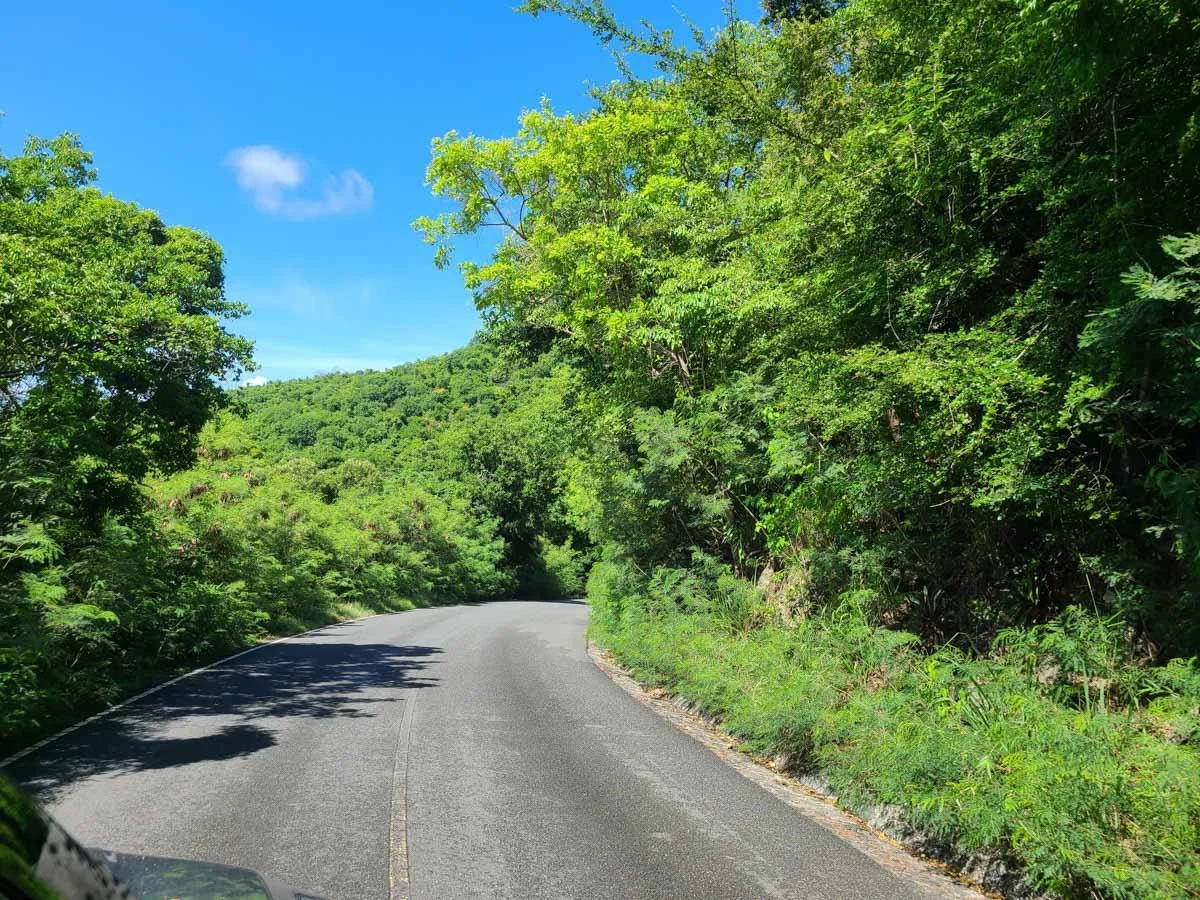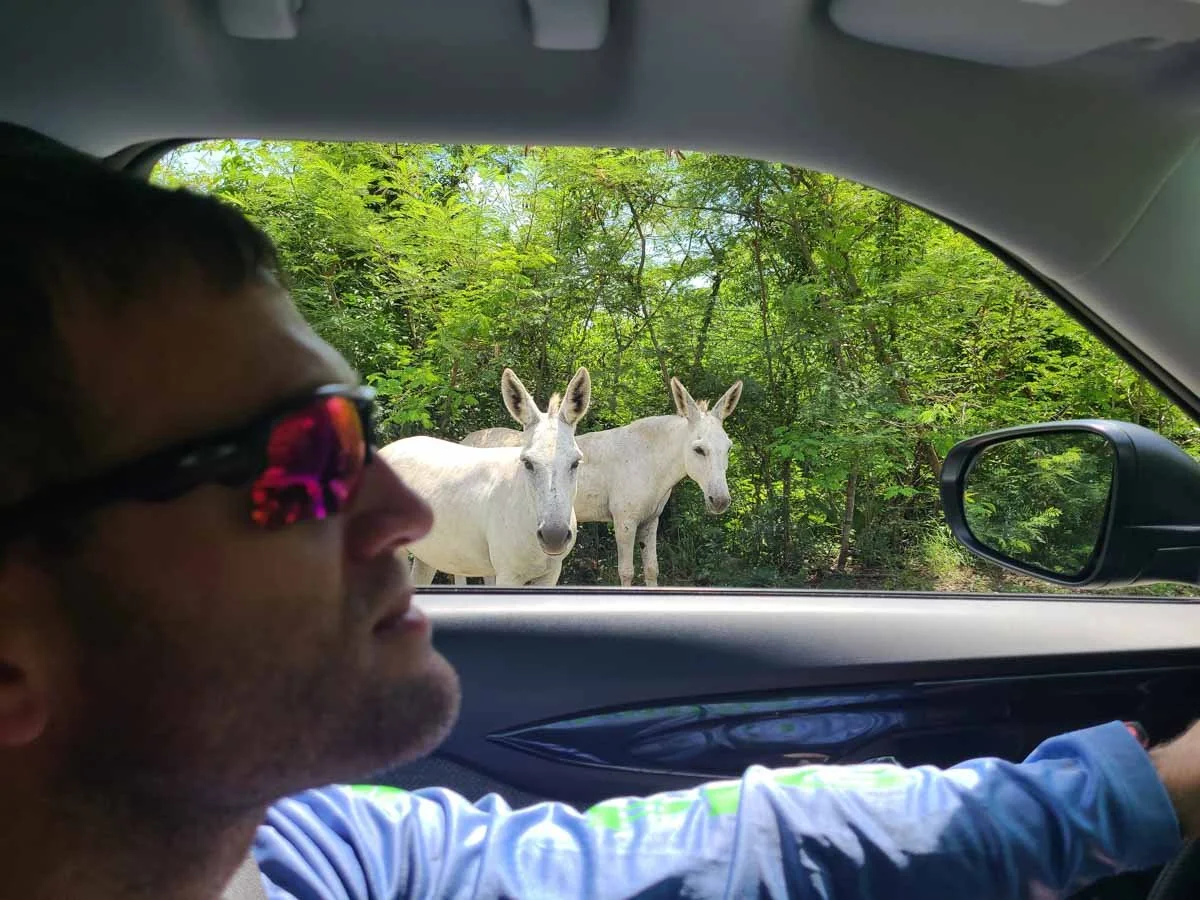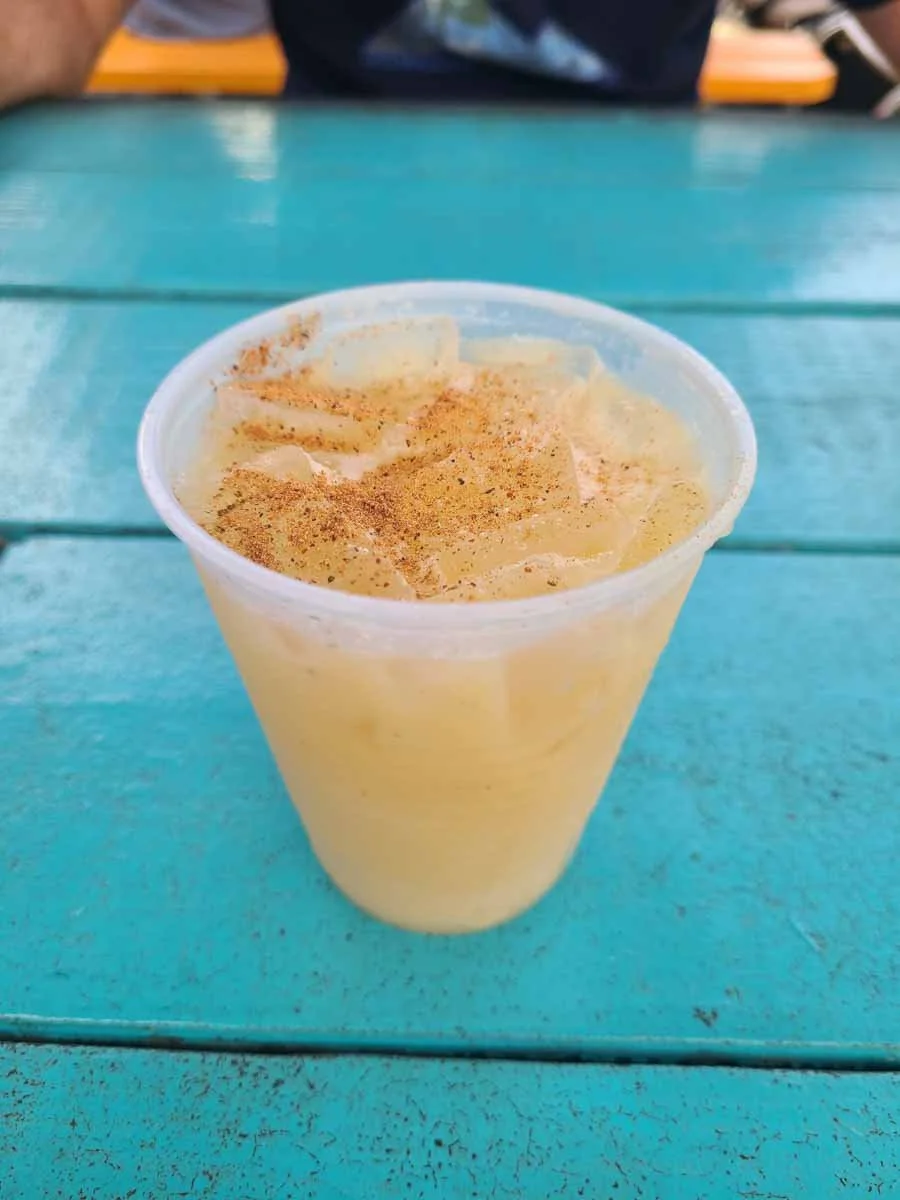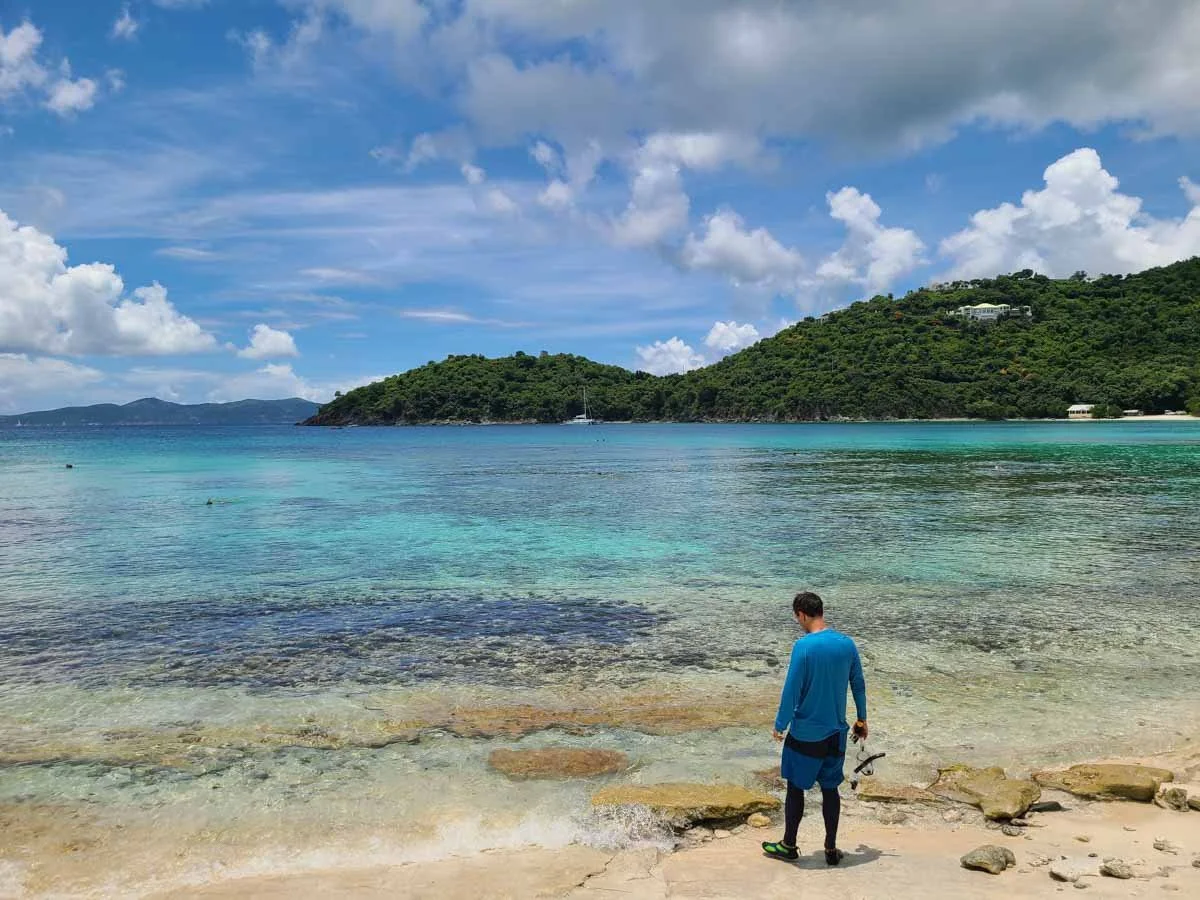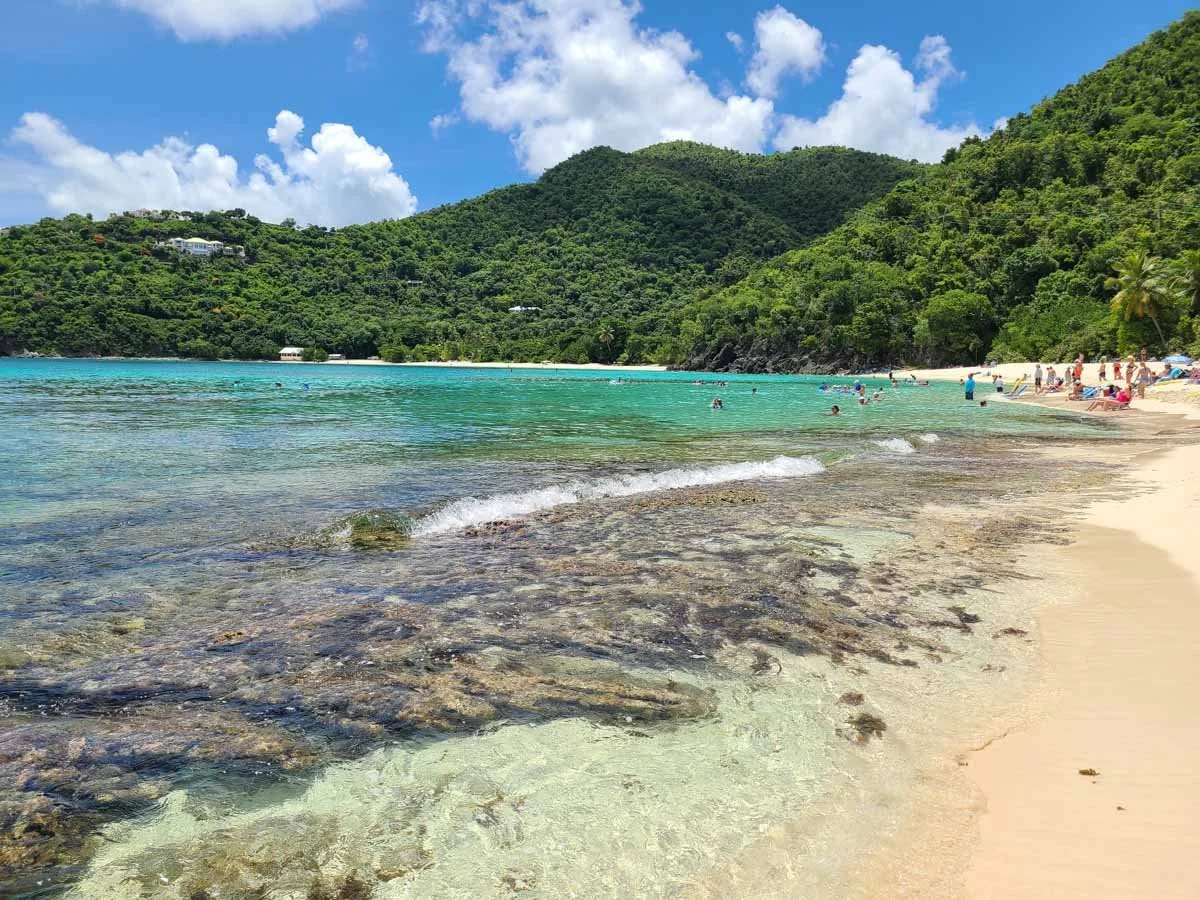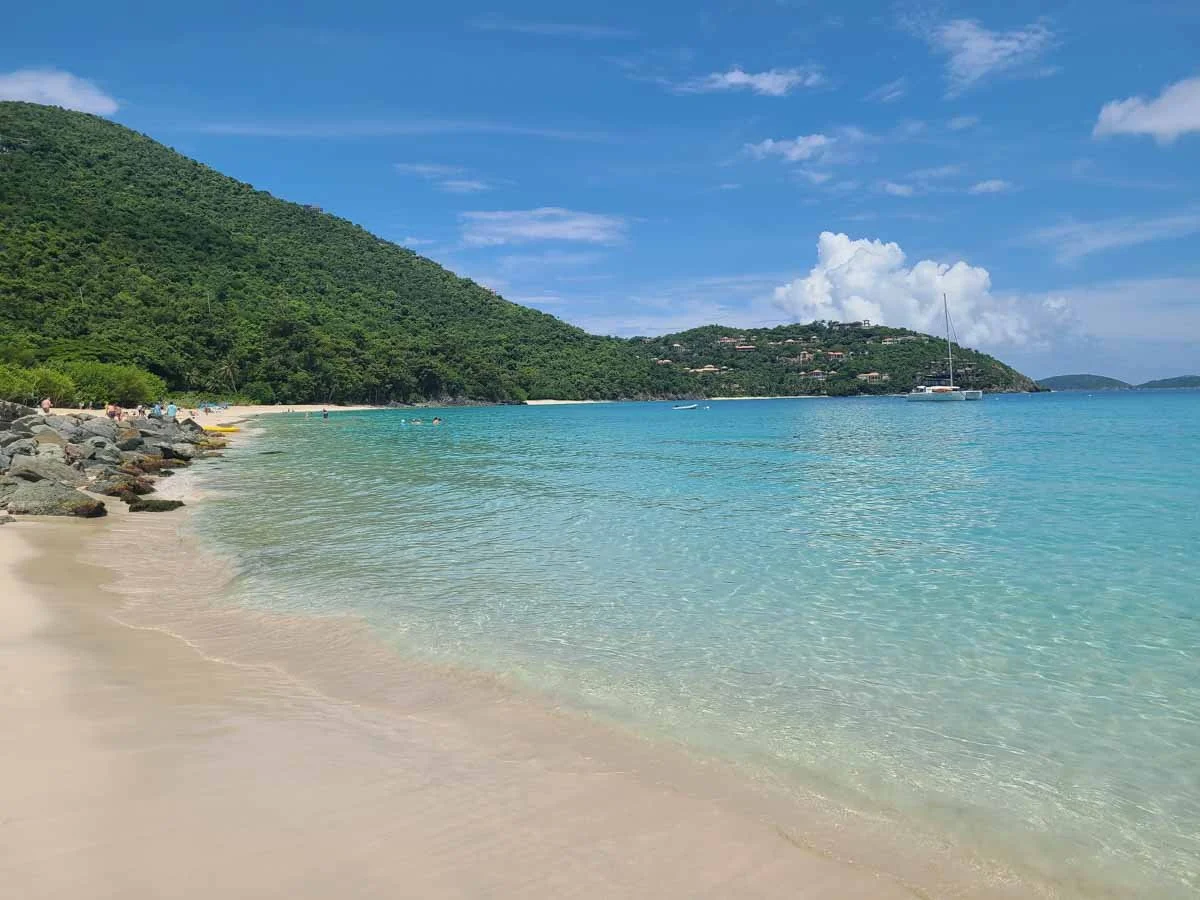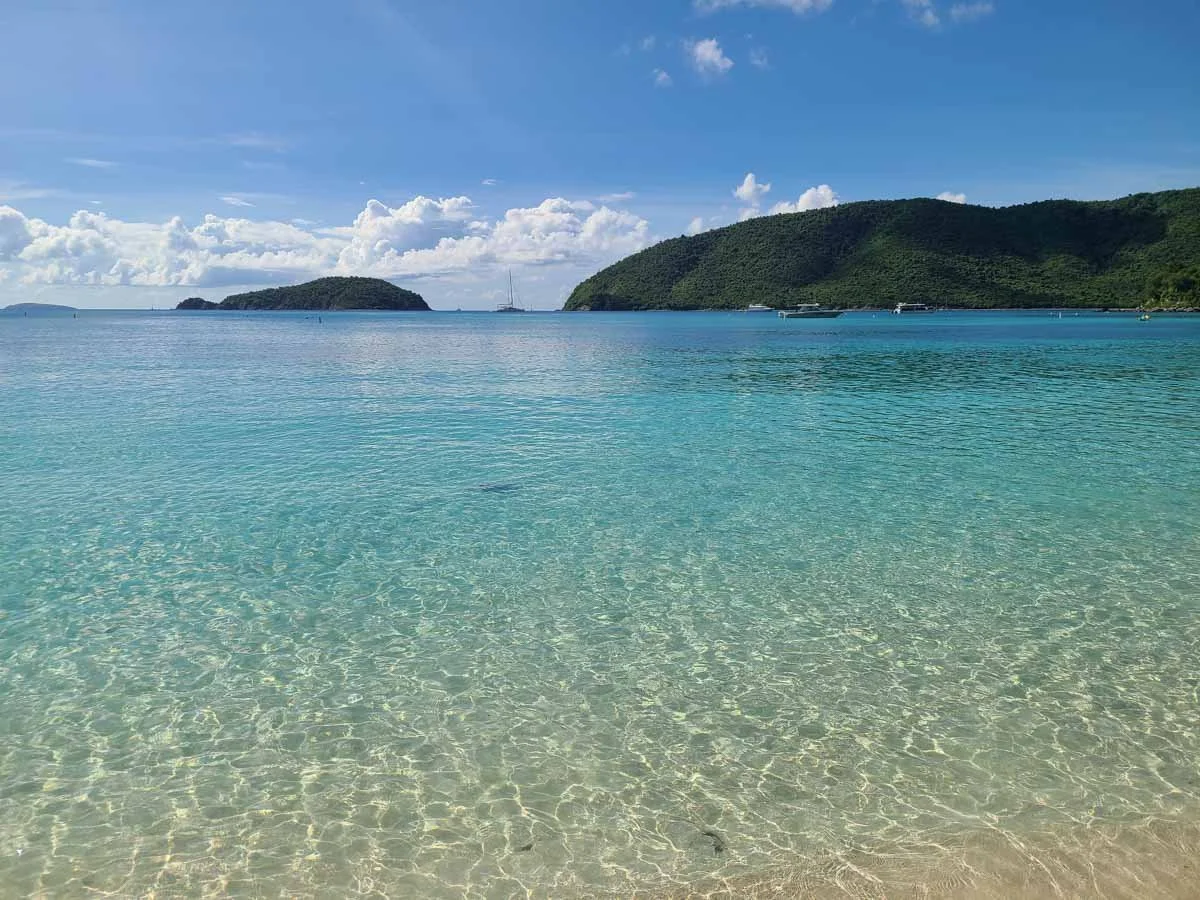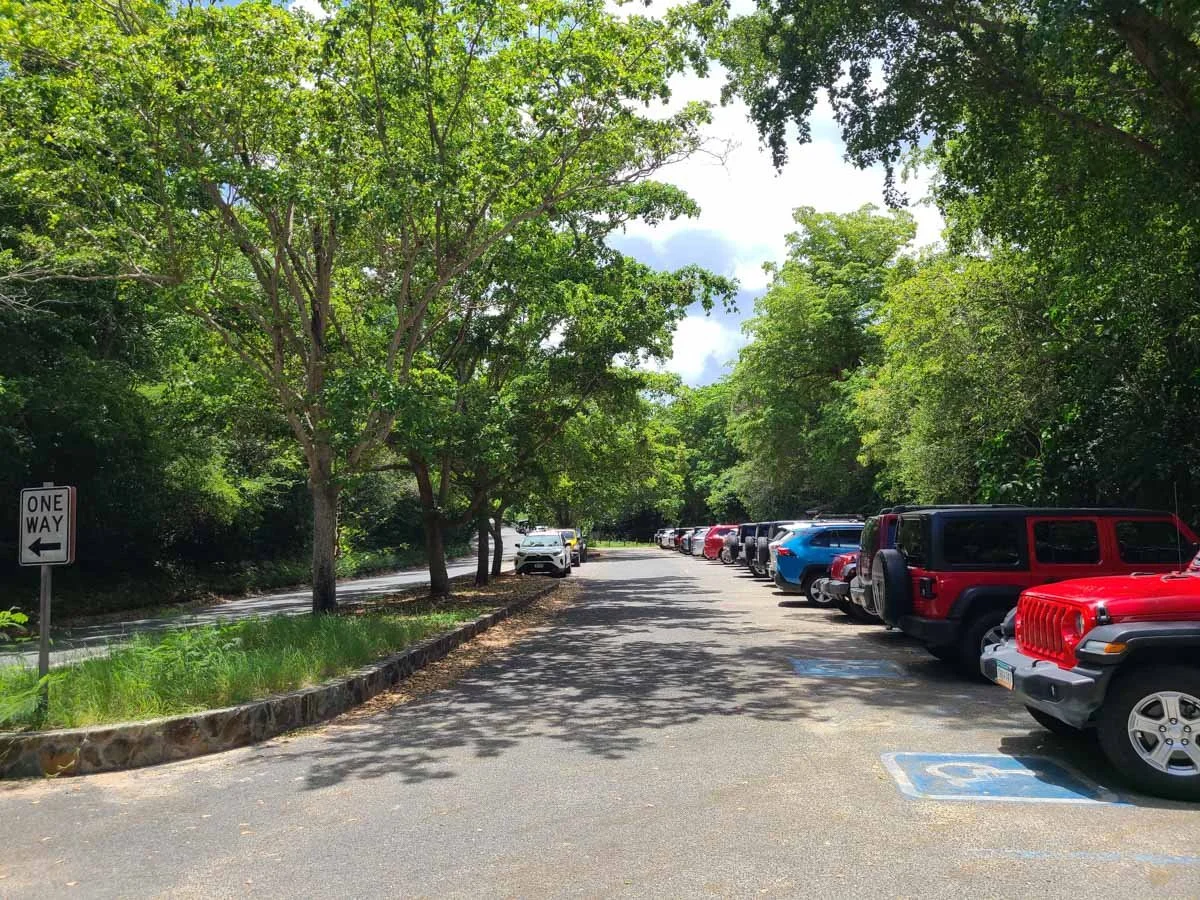How to Visit Virgin Islands National Park: Complete Guide + Tips!
Are you looking to visit Virgin Islands National Park on St. John and wondering how to plan your trip? You’ve come to the right place! In this guide, we cover everything you need to know, including how to get to Virgin Islands National Park, the best time to visit, how to get around, things to do, what to pack, and so much more!
When it comes to the age-old question, “Do you prefer the mountains or the beach?”, our answer in the past would without a doubt always be mountains. But, Virgin Islands National Park, with its collection of stunning beaches and incredible snorkeling spots, just might have brought out our inner beach bum personas after all…
Making up over two-thirds of St. John, one of the U.S. Virgin Islands in the Caribbean, Virgin Islands National Park is a really unique park in the U.S. National Park system- one that feels more like a remote tropical getaway than a National Park destination!
On land, hiking trails weave through tropical forests and lead to historic plantations and ruins. Along the coast, Virgin Islands National Park preserves pristine white sand beaches with crystal clear blue water, and offshore, protects tons of coral reef and marine life (with almost half of the park being underwater!). Though I’ve never been much of a beach person myself, I still to this day find myself daydreaming of that amazingly clear, warm, blue water and those offshore reefs just teeming with colorful tropical fish and coral.
One thing we also really loved about St. John and Virgin Islands National Park in particular was just how remote and undeveloped it felt compared to other Caribbean islands, including the neighboring and more popular Virgin Island, St. Thomas.
The island or the park didn’t feel overrun, touristy, or over-developed. There aren’t a ton of huge resorts lining the beaches. The roads that wind through the hillsides of the islands seem to blend into the landscape when looking at the island from afar, making everything feel more natural and remote. It truly felt like we had stumbled upon a hidden gem of the Caribbean, and it’s not an exaggeration when we say that we feel like this small island and National Park has quite possibly ruined all other tropical beach destinations for us!
Because it feels so remote, a trip to Virgin Islands National Park might feel a bit complicated to plan…but hey, that’s where we come in! In this guide, we’ll go over everything you need to know to help you plan the perfect trip to Virgin Islands National Park. We’ll cover how to get to Virgin Islands National Park, how to get around, where to stay, when to go, what to bring, what to do, what typical costs look like, and more!
In this Virgin Islands National Park guide:
How to Get to Virgin Islands National Park
Virgin Islands National Park is pretty remote as far as National Parks go. It’s located on St. John, a small island in the Caribbean that’s less than 20 square miles. Virgin Islands National Park protects about two-thirds of the island and the surrounding reef.
St. John is so tiny and remote that it doesn’t have its own airport, so getting to Virgin Islands National Park requires a bit of upfront planning.
Here’s the main way to get to Virgin Islands National Park on St. John:
Fly into the Cyril E. King airport on the neighboring U.S. Virgin Island, St. Thomas
Take a ferry from St. Thomas to St. John
The second part of that equation requires a bit more elaboration, so let’s get into everything you need to know about taking the ferry from St. Thomas to St. John…
THe ferry from St. Thomas to St. John
Views from the St. John ferry
There are two main options for ferries between St. Thomas and St. John, and which one you take depends on how you ultimately plan on getting around Virgin Islands National Park (which we’ll talk about next!).
Your two St. John ferry options are:
The passenger ferry
The car barge
The St. John Passenger Ferry
If you don’t have a car on St. Thomas, or don’t plan on renting one for your visit to Virgin Islands National Park, you can take the passenger ferry from St. Thomas to St. John.
These ferries leave from either Charlotte Amalie or Red Hook.
Charlotte Amalie Ferry
The dock in Charlotte Amalie is only about ten minutes from the airport, so it’s a shorter taxi ride than to Red Hook
From Charlotte Amalie, it’s a 45 minute ferry ride over to St. John
It’s a little more expensive than leaving from Red Hook, at $13 per non-resident one-way ($12 for Virgin Island residents)
There are less ferries running each day (only a handful) compared to those leaving from Red Hook
This ferry also only runs in the busier months (it doesn’t operate between July through October)
Red Hook Ferry
Red Hook is on the eastern tip of St. Thomas, about a half hour from the airport, but is only a 20 minute ferry ride to St. John
This ferry costs $8.15 for a non-resident one-way ($6 for Virgin Islands residents)
Ferries run pretty much every hour between 5:30 AM to 11 PM most days all year
You can book St. John ferry tickets in advance online but it’s easy enough to show up to the dock and purchase onboard when you get there. Check the St. John passenger ferry schedules here and remember to have cash on hand to pay in person!
All St. John passenger ferries go to Cruz Bay on St. John, the main hub of the island, where you can grab a taxi or walk into town.
Taking the car barge from St. Thomas to St. John
If you are renting a car on St. Thomas (more on that below) and bringing it over to St. John, then you can take the car barge from St. Thomas to St. John.
There are three main companies of car barges: Love City Car Ferries, Global Marine’s Tug Life, and the Big Red Barge Company.
The Big Red Barge car ferry to St .John
All leave from Red Hook on St. Thomas and go to Cruz Bay on St. John and cost the same so it doesn’t matter too much which one you get- just choose whichever one works with your schedule.
Here are some good-to-know tips for taking the car barge from St. Thomas to St. John:
How long is the car ferry from Red Hook to St. John?
The ferry ride is about 25 minutes.
How much does the car ferry from St. Thomas to St. John cost?
The cost for the St. John car ferry is $50 for a one-way ticket, and $65 for a roundtrip ticket. Some people recommend not buying the roundtrip ticket so that you can be more flexible (since tickets are not interchangeable between the different ferry lines), but we thought the cost savings was well worth it and we had no issue getting on the ferry we needed for our return back to St. Thomas- just make sure you are looking at the correct schedules for the ferry you need!
You can book tickets in advance online for Love City Car Ferries and the Big Red Barge, though this can be risky if you end up missing the ferry. Also, we noticed it said right on Big Red Barge’s website that an advanced ticket does not guarantee you a spot on any given ferry! It all depends on how busy it is, what the line looks like for the ferry, and how early you show up. So it’s actually generally not recommended to purchase a St. John ferry ticket online in advance.
You can purchase a ticket in person once on the car barge. An attendant will be walking around checking for tickets and collecting money…be sure to have cash as this is the only way to pay for a ticket onboard!
Port fees: Just a heads up, you’ll also have to pay a small port fee before boarding the St. John car barge in Red Hook only ($3 dollars for standard passenger vehicles, paid in cash at the booth at the dock).
How often does the ferry run between St. Thomas and St. John?
The car ferries between St. Thomas and St. John in general run between 6 am to 7 or 7:30 PM. You can check the schedules for Love City Car Ferries and the Big Red Barge online.
Note that some of the Love City Car Ferries are seasonal (marked with the double asterisk). When we were first looking at the schedules, it was hard to tell what months were considered seasonal, and if those ferries would be running when we were there in June. We found out there that those ferries were indeed not running, so fyi, June is out of high season for them, but we realized that if in doubt, start the online booking process and see if those ferry options are available for your desired dates. If not, then they are not running the seasonal ferries at that time.
The car barge from St. Thomas to St. John
Do I need to get to the St. John ferry early?
Before heading to Virgin Islands National Park, we read many things online and in forums that worried us…things like the car barges being unpredictable, unreliable, and often down for repairs. And what stood out to us most were the multiple warnings advising us to show up at the ferry dock at least 45 minutes to an hour early in order to get in line. We also read in places that the barges can get very busy, especially on weekends and on the last barges of the day.
Reading all of this definitely had us worried because of the timing of our flight, which was set to arrive later in the afternoon. Here, we’ll share our personal experience to give you an idea of what to expect when taking the car barge to St. John and how you might want to plan out your schedule to avoid any particularly stressful situations…
Our flight was set to arrive in St. Thomas at 3:30 pm…we thought that was plenty of time to make one of the ferries out of Red Hook, especially the last one at 7 pm…even with the half hour drive from the airport to Red Hook and the supposed need to be in line at the dock an hour early.
Well…not so fast. Because as Murphy’s Law would have it, we had quite the delay at our layover in Puerto Rico, where all flights ended up being grounded right as our incoming flight landed. Of course.
As the time ticked away with no flights moving, our stress levels were definitely rising as the possibility of catching that last ferry out of Red Hook was quickly fading, and our minds were quickly going through the alternatives of how we would get to St. John, or how we would maybe even have to spend an unplanned night on St. Thomas.
The St. John car ferry
It was during our stressful brainstorming when a nice local of St. John overheard us and came to relieve our anxiety. She told us not to stress, that we had plenty of time to make the last ferry, and that ferries won’t leave anyone behind. She said that if they see cars still coming toward the port, they’ll wait, and may even come back if they already left the dock and didn’t get too far, and that they squeeze on as many as they can if they need to. She shook her head at the idea of needing to be at the dock an hour early to wait in line. So, we put our trust into this friendly local’s perspective and felt a little bit less stressed.
Eventually, our flight ended up taking off and luckily, the car rental process at the airport went relatively quickly and smoothly. We were in our rental car and on our way just after 6:30 pm. With a half hour drive ahead of us to Red Hook, and a last ferry departure at 7 pm, you can bet that this drive was one of the most stressful we ever had!
We ended up getting to the Red Hook ferry dock a few minutes past 7…luckily the barge was still there (they probably saw us coming!), we quickly paid the dock fee, and we were ushered up onto the ferry. Before we even stopped our car and put it in park, the ferry was already on the move. We had quite literally just made it.
Phew! My stress levels were rising again just from writing this.
Of note, despite it being the last barge of the day, there were only a handful of cars…the ferry was nearly empty.
On the way back from St. John to St. Thomas, our experience was luckily much less eventful. We showed up to the Cruz Bay ferry dock on St. John 20 minutes early for the 8:30 am ferry. At that time, they were actually still loading up the 8 am ferry, and once that left, we were the third car on the 8:30 am barge. I don’t think it got completely full, and it left around 8:35 or so.
We share our story for a few reasons:
First, despite the numerous warnings we read online…no, we didn’t need to stress out about showing up an hour early. The barges weren’t full. It might be because we didn’t use the barges on the weekend, and it wasn’t entirely peak season (we visited in June).
With that said, I would still recommend to be more cautious with your time if visiting in the high season (November through April)…make sure to have contingency time in your schedule to get to the dock early to be on the safe side, or to have wiggle room in case you can’t get on your desired ferry and have to wait for the next one. In the slower season of June, we had no issues other than our delayed flight, which brings me to my next point…
If you plan on renting a car to visit Virgin Islands National Park (which we highly recommend!), you might want to consider where you rent it from (St. Thomas vs. St. John). Relying on the car barge with its limited schedule can add an extra layer of stress as it did for us, especially if your flight is arriving later in the day or unplanned delays happen.
So, let’s get into ways to get around Virgin Islands National Park next, where we’ll talk about tips for driving around St. John and the pros and cons of renting a car in St. Thomas vs. St. John.
How to Get Around Virgin Islands National Park
There are a few ways to get around St. John and Virgin Islands National Park, but first, let’s do a quick overview of how the park is laid out across the island to give you a better idea of where you’ll be needing to go on your visit.
Overview and Map of Virgin Islands National Park
This Virgin Islands National Park map is taken from the park brochure and gives a good overview of all the main places to visit.
On this Virgin Islands National Park map, we’ve labeled Cruz Bay and Coral Bay, the two main towns on St. John. The two main roads across the park are red on the map (North Shore Road and Centerline Road).
Cruz Bay is the town on the west end of the island and is the main hub of St. John. It’s where the ferry docks, the park visitor center, and the main places to stay in St. John are located.
From Cruz Bay, North Shore Road (route 20) and Centerline Road (route 10) are the two main roads through Virgin Islands National Park.
North Shore Road, as the name suggests, runs along the northern edge of St. John. Along this road are many of the best places in Virgin Islands National Park, including all the sought-after white sand beaches that bring people to this National Park- places like Trunk Bay (named the world’s most beautiful beach!), Cinnamon Bay, and Maho Bay.
Centerline Road runs through the center of the island from West to East. You’ll drive up through the tops of the tropical forest-covered hills, and along the way there are some ruins and trailheads. Up here, you’ll also find the famous Windmill Bar, where you can get amazing views over the ocean as you sip on the island’s specialty Painkiller drinks.
Both North Shore Road and Centerline Road converge in Coral Bay, a small town on the eastern side of St. John. From Coral Bay, you can explore the east end of St. John and Virgin Islands National Park, which has some more beaches with good snorkeling, or you can head south towards the Salt Pond Bay and Ram Head area (one of our favorite places in Virgin Islands National Park!).
Getting around Virgin Islands National Park
Now that we’re better oriented with the island, how do you get around Virgin Islands National Park?
Well, there are two main ways:
Rent a car
Rely on taxis
We think the best way to get around the island is by having your own car, giving you the freedom to go wherever you want, whenever you want. But it can be more expensive, and you’ll have to deal with the car barge.
Let’s go over the pros and cons of both!
Taxis on St. John
If you don’t want to deal with renting a car, you can easily get around Virgin Islands National Park by taxi. You’ll see tons of what they call safari-style open air trucks that can carry dozens of people to various popular destinations across the park. We don’t have any personal experience using these, but we saw them all around North Shore Road and the more popular beaches.
A full taxi heading down North Shore Road in Virgin Islands National Park
If you’re coming to St. John from the passenger ferry, there will likely be taxis waiting for you at the docks, and if staying somewhere on the island, the host will often have recommendations for calling one.
Once you get to your destination, you may be able to arrange a time for the taxi to come back and pick you up, or if it’s a popular place like Trunk Bay, you might just be able to snag one that’s waiting around in the parking lot (but be prepared to have to wait until the taxi fills up before it leaves).
A truck taxi at Cinnamon Bay waiting to fill up
The nice thing about taxis on St. John is that they operate under set rates that are per-person, so there’s no haggling or stressing about what you will have to pay. Check out the St. John taxi rates here to give you an idea of how much different destinations will cost.
Depending on how long you plan to be on St. John and how many people you’re traveling with (that can split costs), relying on taxis may be the cheaper way to go over renting a car, and is a great option if you’re okay with being a little less independent and flexible with your time.
Driving on St. John
We rented a car to get around Virgin Islands National Park and are definitely happy we did. It allowed us the most freedom, to pack all our necessities in the car, and to stay further outside Cruz Bay at a cheaper location where nothing was really in walking distance.
Though we think renting a car is the way to go for those staying a few days or more in the park, there are definitely some tips and need-to-know information for driving around St. John that we want to share with you based on our own experience!
Driving around St. John
Should we rent a car in St. Thomas or St. John?
First things first, on which island should you rent your car? There are definitely pros and cons to each, with plenty of options on both islands.
Renting our car on St. Thomas seemed like the obvious choice to us at first. We could get a car right at the airport and continue on without having to take any taxis. St. Thomas also seems to have slightly cheaper rates, with more well-known car rental companies like Enterprise and Avis. Like we said, it seemed like the obvious choice, that is, until we had our car ferry fiasco that we explained above.
If you rent a car on St. Thomas, you definitely have to be mindful of when your flight gets in, and really consider the possibility of delays or hangups along the way that might cause you to miss the last car ferry to St. John (the car ferries don’t run nearly as late into the evening as passenger ferries). We had read quite a few stories of missed ferries before going, which made me a bit nervous.
If you do miss the last car ferry to St. John, the only option is to pay to park your car somewhere in Red Hook, take the next passenger ferry to St. John and then a taxi to your accommodation for the night, and then return to Red Hook on the passenger ferry the next morning to get your car and bring it back over to St. John on the car barge. Just the thought of potentially having to do that after our delayed flight felt like such a huge hassle and waste of time.
We also pondered the idea of just finding a last minute place to stay in St. Thomas for the night and eating the cost of our first night in St. John, but that was a tough pill to swallow given how expensive accommodation is on these islands. In the end, we didn’t have to do either of these as we just nearly made the last car ferry to St. John, but it did give us some good experience that we can now pass on to you!
Our biggest tip? Only rent a car in St. Thomas if your flight is scheduled to arrive in the morning, or if you are already in St. Thomas on vacation and just want to rent a car to head over to St. John for a few days. Arriving in the morning gives you some contingency time for delays and hold ups, which hopefully won’t be long enough to have you miss the last car barges of the day.
If your flight arrives in the afternoon, we’d say to learn from our mistake and either plan to spend your first night on St. Thomas and take the first car barge to St. John in the morning.
Alternatively, just rent your car right on St. John. This would require you to take a taxi from the airport to either Charlotte Amalie or Red Hook and take the passenger ferry to St. John, where you’d then pick up your rental car.
If you rent a car on St. John, you might pay a little more on daily rental fees, but it can make getting to Virgin Islands National Park a little less stressful if you have a later flight. Often, car rental staff will be waiting for you right at the dock in Cruz Bay, and we read that they may be even provide free downtown parking for you during your stay (a huge perk!). While you’ll have to pay for a taxi from the St. Thomas airport and maybe a bit more in rental costs, you won’t have to pay for the car barge (way more expensive than a passenger ferry), or the potential costs of missing the car barge when you arrive.
Want the TL;DR version of renting a car in Virgin Islands National Park?
Renting a car on St. Thomas: Cheaper, more convenient (right at the airport), but possibility of missing the last car ferry to St. John
Renting a car on St. John: A bit more expensive, requires a taxi on St. Thomas, but more flexibility for getting a ferry to St. John without worrying about missing one
Paradise Point Lookout
Drake's Seat Overlook
What type of car do you need in Virgin Islands National Park?
We recommend having some sort of high clearance vehicle for driving around Virgin Islands National Park. Although most are paved, the roads on St. John are steep, narrow, and can be pretty rough and rugged, and having that extra clearance was definitely a good thing.
We had actually originally rented a compact car (because it was cheaper!), and even the guy at the rental place was surprised when we told him we were going over to St. John. Luckily, we had a free upgrade available for us to use (the perks of being brand loyal!), and we were able to get an SUV. As soon as we started driving on St. John, we were happy we had that upgrade.
As we drove around St. John, we did notice that nearly every other car seemed to be a Jeep. It seemed to be the thing to rent around here, but we would say it’s more of a novelty than a necessity.
So many Jeeps!
Most roads on St. John that you’ll be driving are paved and require no off-roading. The one exception in Virgin Islands National Park is the road to Little and Great Lameshur Bay, which is a rugged dirt road on the southern coast of the island for which the park service recommends having a 4x4 vehicle. We didn’t feel comfortable taking our standard SUV down this road, but this is the kind of thing Jeeps are meant for.
So if it’s important to you to take your car off-road or visit the more remote bays and beaches on the island, you might want to consider renting a Jeep. Otherwise, if you plan to visit just a few of the standard more popular beaches (especially those on North Shore Road) and trails off the main park roads, you’ll be more than fine with a regular SUV in Virgin Islands National Park.
North Shore Road in Virgin Islands National Park
Tips for Driving in Virgin Islands National Park
Here are some of our best tips for driving on St. John!
Drive on the left! Even though cars are typical American cars with the steering wheel on the left, you also drive on the left here, too! With the roads as winding and narrow as they are, it can sometimes be hard to wire that into the brain as you are focusing on so many other things.
As you’re driving, also be extra aware of other tourists who may forget which side to drive on. It happened to us a few times where we turned a corner and found ourselves head on with a driver heading towards us on the wrong side of the road. We even saw an accident in downtown Cruz Bay that looked to be the result of someone who pulled out onto the road and into a car who was on the wrong (a.k.a right) side.
Take it slow. The roads in Virgin Islands National Park basically climb up and down the hills that make up St. John. Most are paved and wide enough for two- way traffic, but they are often still pretty narrow and tight, very twisty with lots of sharp and blind turns, and very steep…and sometimes all of the above at once! Don’t expect to drive anywhere too fast, and don’t try to. You’ll likely be going about 20-25 mph on average.
A typical view of the road while driving in Virgin Islands National Park- they get pretty steep and winding!
Steep roads with blind turns are the norm in Virgin Islands National Park
Be on the lookout. There will be people on the roads, stray chickens, and even groups of friendly donkeys! Be cautious around blind and sharp turns where things can get tight and people can be pulling out in front of you around the blind turn.
Friendly donkeys along the road!
Use caution in town. Downtown Cruz Bay seemed particularly chaotic. At times, it seemed like there were no rules to the road (for example, we noticed the use of signal lights was definitely not a thing, and I don’t remember seeing a single traffic light).
Listen for trucks. When driving the winding roads across the island, listen for loud horns, which means a big truck is coming in the opposite direction…be prepared to pull over.
Getting gas. Gas was cheaper on St. Thomas, so try to wait to fill up there if that’s where you rented from.
Parking in St. John
Parking in Cruz Bay on St. John is tough, as it’s so limited. We attempted to find a free place to park once to head into town and get some ice cream, but quickly gave up as people were fighting for spaces. This is a great site that shares some free and paid parking options in Cruz Bay. One that we noticed while driving around was the Lumberyard, which you can pay online for.
Parking at various places in Virgin Islands National Park is also limited, with many lots for beaches and trailheads being pretty small. Many people, including the NPS website, will tell you to get an early start to guarantee parking (the park recommends before 10 am). When we were there, we only had issues at Trunk Bay (understandably, as it’s the most popular beach), but everywhere else we were able to easily park throughout the day. We did visit in June, though, which is not considered peak season, so we can imagine parking would be a bit more difficult during the busier times (December through April).
Where to Stay in Virgin Islands National Park
There is only one option for staying in Virgin Islands National Park (at a campground). For anything else, you’ll be staying just outside the park near either Cruz Bay or Coral Bay, but never too far from any of the best places in Virgin Islands National Park. Let’s get into your options now…
Virgin Islands National Park camping
There is only one option for staying inside Virgin Islands National Park, and that is the Cinnamon Bay Beach and Campground.
This is located right at Cinnamon Bay Beach, giving you a chance to camp with direct access to one of the best beaches on St. John! There’s also a restaurant, food truck, camp and gift shop, and rentals for snorkels, kayaks, paddleboards, and beach equipment.
The beach at Cinnamon Bay Campground
There are three main options to choose from when staying at Cinnamon Bay:
A bare tent site, where you’ll have to bring everything (your own tent, sleeping bags, cookware, etc). There is an option to rent these things through the company for an extra cost.
An ecotent, with beds, sheets and pillows, a table and chairs, an electric outlet, and cookware and dishes.
A cottage, with all sleeping and cooking gear needed.
None of the places have their own bathrooms. Instead, there are four shared bathhouses that can also be used by general visitors to Cinnamon Bay.
Cinnamon Bay Campground is definitely the cheapest option to stay while visiting Virgin Islands National Park and ideal if you like camping. We pondered it for a bit because we usually tend to camp to save money, but the dealbreaker for us was not having air conditioning (none of the sites or cottages have this). We knew the island was going to be hot and humid, and trying to sleep without some sort of relief from the heat would just not be happening for us (as was proven by the one night we lost power in our Airbnb for an hour or two and struggled to sleep!).
Other places to stay on St. John
There are tons of places to stay on St. John. Many of them are in Cruz Bay, the main hub on the west end of the island where the ferry docks are located. There are many hotels, villas, Airbnbs and resorts to choose from, and lots of restaurants in the area.
If you don’t have a car, Cruz Bay is a good place to stay so that you can walk into town for food and grabbing taxis to get to various places in Virgin Islands National Park.
A view over Cruz Bay on St. John
If you’re looking to stay a little bit out of the chaos of the downtown area, Chocolate Hole is an area just to the south of Cruz Bay and has plenty of accommodation options.
We stayed even further afield, at an Airbnb towards the top of Gift Hill Road, which connects Chocolate Hole to Centerline Road. It’s a more remote location, and the fact that it didn’t have a glamorous villa view meant it was on the cheaper end of things.
Once you start looking for accommodations on St. John, you’ll realize that it’s a pretty expensive place to visit, but you will still find a full range of places from small, cheaper guesthouses further from town without special views, to gorgeous oceanside villas with spectacular views over the Caribbean, and everything in between, so it’s really just a matter of going with whatever fits in your budget.
On the other side of the island is Coral Bay. As one local put it, if Cruz Bay is like the city, then Coral Bay is more like the country. It’s smaller and quieter, but still with its own collection of restaurants and accommodations.
A view over Coral Bay
No matter where you stay, because the island is so small, you’ll never be too far away from any of the main attractions in Virgin Islands National Park.
We used Airbnb to find accommodations on St. John, which had some cheaper options, but we also saw that you could use this villa rental site, often called “the Airbnb of St. John” to find gorgeous villas if that’s in your budget.
Where to eat in Virgin Islands National Park
Within Virgin Islands National Park itself, there are a few small places to grab a quick bite while you are out and about. There is a café at Trunk Bay, an open-air restaurant and food truck at Cinnamon Bay, and Maho Crossroads (across the street from Maho Bay Beach) has a variety of food trucks to choose from (this area is only open until 4 pm).
Cruz Bay and Coral Bay each have a collection of restaurants. One of the more unique ones in Coral Bay is Lime Out, a floating restaurant that requires a kayak or boat to get to.
The Windmill Bar is also a very popular place to eat. Sitting high up in the mountains along Centerline Road, you can get great views of the ocean while sipping on a drink. A helpful note: When we visited, they were charging $5 for parking at the restaurant, so come with cash.
We ate at the restaurant just across the street, Shambles Bar and Grill, which had decent food and a good Painkiller (the famous drink of the Virgin Islands).
St. John’s famous drink- the Painkiller
Eating out can be expensive on St. John, so you might be thinking of buying groceries and cooking as a way to save money, which is what we did. We will say that it is cheaper than eating out, but it is still not cheap! We noticed that most things were about 2 to 3 times more expensive than stuff back home. We shopped at the Starfish Market in The Marketplace plaza in downtown Cruz Bay, which had everything we needed.
Best Time to Visit Virgin Islands National Park
The busiest season in Virgin Islands National Park is from November to April, and many would say that this is the best time to visit the park (though keep reading for our personal opinion…).
While the temperatures and weather don’t vary too much throughout the year, these winter months are slightly less hot (think high 70s to low 80s instead of high 80s), with maybe a tad bit less humidity.
The drier months of the year also tend to be February to April.
The caveats are higher crowds (beaches may be packed and you may have trouble finding parking at the various hotspots throughout the park) and higher prices for things like accommodations, car rentals, and flights.
Another thing to note about this time of year on St. John is that winter can bring stronger winds, creating winter swell events that may affect the popular North Shore beaches especially. These events may stir up the water enough to make snorkeling impossible, or may even cause beach closures due to unsafe conditions. So keep this in mind if getting in the water, and especially snorkeling, are important to you. You can always head to the beaches on the south end for snorkeling, which are usually protected from the Northern swells, as an alternative.
Snorkeling was a huge reason we visited Virgin Islands National Park! Check out all our favorite places to snorkel in Virgin Islands National Park for seeing beautiful coral, swimming with turtles, and more.
Like we said, though, the weather doesn’t have too much variation throughout the year, with temperatures ranging from the high 70s to high 80s, and the humidity levels falling somewhere in the 70 percent range (sometimes into the 80 percent range on particularly bad days)…yea, it’s hot! It’s the kind of weather where it feels stuffy and heavy as soon as you walk outside, so just be prepared for that (luckily there are tons of beaches to cool off in!).
And even though some months tend to be “rainier” or “drier” than others, there isn’t a true rainy season on St. John. In our experience, rain tended to come in very short bursts that lasted about 5 minutes before the sun came back out, and actually, they were pretty refreshing in the hot weather! Often, they came at night or in the morning before we left for the day, and then occasionally we had one quick 5- minute shower in the middle of the day, so they really weren’t a big deal.
Most days in the forecast may actually show rain and thunderstorms, which had us a bit worried in the weeks leading up to the trip (anyone else obsessively check weather forecasts way too far in advance for a vacation, or is that just me??). But don’t let this worry you too much…all of our days ended up being sunny and beautiful, with no thunderstorms and only a few of those occasional brief showers on just a few days.
So, in general, no matter when you visit Virgin Islands National Park, expect sunny, hot, and very humid days with potentially brief (and refreshing) showers here and there, unless, of course, a more obvious system is moving through, which brings me to my next point…
A small distant rain shower seen from across Salt Pond Bay on St. John
The only thing you really have to be aware of when deciding when to visit Virgin Islands National Park is hurricane season, which runs from June to November every year, with its peak historically between August and October.
During the months of August through October, the island gets the most rainfall and storms, but of course, there are lower prices and fewer crowds. If you want to take advantage of the low season in Virgin Islands National Park, our advice would be to keep a close eye on the weather and plan to book something last minute once you know the forecast looks clear, or make sure all your plans are refundable or covered by travel insurance in case you have to make a last-minute cancellation. You can track the Atlantic hurricane season here.
It’s also good to note that between August and October, since it’s low season, many restaurants, some guided tours, and tourist hubs may be closed this time of year and you might have a more limited selection of accommodations.
So, winter is busy and crowded but has nice weather, while late summer and fall bring us to hurricane season. That leaves us with spring, which is exactly when we visited the park!
We may be biased here because we can only speak from our own experience, but we think spring (April to June) is an amazing time to visit Virgin Islands National Park! We visited in early June specifically and were really happy with our choice.
The temperatures were hot and humid as expected (we experienced temperatures around 88 to 90 degrees) with humidity often in the 70% range (but it sometimes snuck up into the low 80s), but not different enough from any other time of year to really matter to us. And while June is considered the start of the hurricane season, they are rarely seen this early in the year so it’s likely still a safe bet (though you never know with any given year!).
But the best part about visiting Virgin Islands National Park in June? There weren’t a lot of people!
Honestly, I think this played a huge factor in why we had such a great experience in the park. We had read often to get everywhere early because parking is limited, and you might be sitting on top of people at popular beaches. In June, we didn’t experience this at all (and a local did confirm with us that things had definitely winded down from the busy winter season). We never had to worry about parking at any time of day (the one exception being Trunk Bay, which is expected), the beaches weren’t overly crowded and you could definitely spread out, and we didn’t get the whole touristy over-crowded island vibe at all. Instead, we kind of felt like we had stumbled upon this remote hidden gem of an island, which made the whole experience so much better.
Enjoying uncrowded beaches in Virgin Islands National Park!
So, in general, we think the later spring time is a great in-between time to visit Virgin Islands National Park, with a good balance of fewer crowds, great weather, and mid-range prices. The only minor caveat to visiting in the spring is that some services may be winding down (particularly guided hikes with the National Park Service, and some of the seasonal ferries may not be operating), but this didn’t negatively affect our time at all during our visit.
Things to Do in Virgin Islands National Park
For such a small island, we were actually pretty surprised at all the things to do in Virgin Islands National Park! There are tons of amazing beaches to visit, some of the best snorkeling we’ve ever done through off-shore reefs, other water sports like kayaking and paddlepoarding, hiking trails through the tropical forest, and historic plantations and ruins where you can learn about the interesting history of the island.
At first, the list of things to do in Virgin Islands National Park might sound redundant…there are a lot of different beaches and snorkel sites to visit and, like us before our visit, you might be thinking that once you’ve seen one, you’ve seen them all. But that is definitely not the case!
Every unique beach, trail, reef, and ruin offer something a little bit different, and let’s be real…who would get sick of warm, crystal clear, blue waters and white sand beaches? Even after four days of visiting multiple beaches and snorkel sites a day, I still felt like there were more I wanted to see.
If you’re looking for a more detailed and comprehensive list, be sure to head on over to our complete guide to all the best things to do in Virgin Islands National Park…we’ll go over all the best beaches, trails, and snorkel sites in more depth and share everything you need to know!
But in the meantime, here’s a brief overview of some of our favorite places and things to do in Virgin Islands National Park.
Hawksnest BAY
Hawksnest Bay
This is a small but very picturesque beach on the North Shore of St. John. It has some amazing snorkeling along shallow reefs right off shore!
Peace Hill Ruins
Peace Hill Ruins
These ruins are an easy and quick stop to make off of North Shore Road. You’ll get to explore an old windmill while being treated to great views over both Hawksnest Bay and Trunk Bay.
Trunk Bay
Trunk Bay as seen from North Shore Road
Called the “most beautiful beach in the world”, this beach has quite the title to live up to! With its beautiful stretch of white sand and crystal clear blue water, it doesn’t make it too hard to see how it got this accolade. While Trunk Bay is the only beach in Virgin Islands National Park that requires an amenity fee (just $5), you’ll get access to things like snorkel rentals, beach chair rentals, food options, and an underwater snorkel trail.
Cinnamon Bay
Cinnamon Bay
Cinnamon Bay is another gorgeous North Shore beach, and the longest one on St. John. You can rent paddleboards and kayaks, snorkel around the offshore cay, swim in the gorgeous blue water, and visit the Cinnamon Bay Ruins on the nature trail across the street. Here, you’ll also find the only camping and accommodations in Virgin Islands National Park.
Maho Bay
Maho Bay
Maho Bay is a great place to spend the day and a popular beach for snorkeling. In the center of the bay is a huge seagrass bed where turtles are often found munching and swimming, and on the edges of the bay are rocky reefs with lots of fish and coral. Across the street is Maho Bay Crossroads, which has food trucks, drinks, and paddleboard, kayak, and snorkel gear rentals.
Francis Bay
Francis Bay
Found just adjacent to Maho Bay, Francis Bay is another great place to spot sea turtles and relax on the beach, but with less crowds compared to Maho Bay.
Annaberg Plantantion Ruins
Annaberg Plantation Ruins
The Annaberg Plantation is the biggest and most extensive set of ruins on St. John. Here, you can walk a small loop trail through the ruins, with interpretive signs throughout to teach you more about the history of the area. You’ll also get some of the best views in Virgin Islands National Park over the beautiful blue Leinster Bay and out to the British Virgin Islands.
Waterlemon Cay
Walking the Leinster Bay Trail to Waterlemon Cay in Virgin Islands National Park
Waterlemon Cay is a small island off the North Shore coast, and has some of the best snorkeling in Virgin Islands National Park! It requires a short 20 minute flat walk along the Leinster Bay Trail, and then a brief swim across the bay to get to the colorful reef that surrounds the cay. You’ll have the opportunity to see tons of colorful fish and coral, sea turtles, starfish, and other marine critters. It was definitely one of our favorite things to do in Virgin Islands National Park.
The Murphy Great House Ruins on Windy Hill
Views from the Windy Hill Ruins
Perched just above Waterlemon Bay in Virgin Islands National Park are the Murphy Great House Ruins, which sit on top of Windy Hill along the Johnny Horn Trail. Because they require a bit of a hike to get to, these ruins don’t come with crowds that some of the more popular and more accessible St. John ruins may have, and it’s a great little hike to pair with a visit to Waterlemon Cay. Visit our Guide to Waterlemon Cay to learn more!
Salt Pond Bay
Salt Pond Bay
This beautiful beach is found along the south shore of St. John. It requires a short quarter mile downhill hike to get to, which means it’s a bit less crowded than some of the more popular North Shore beaches. Plus, it’s a great place to snorkel with sea turtles, and to see some cool fish and marine critters in the rocky reefs on the edges of the bay.
Ram Head Trail
Views from the Ram Head Trail in Virgin Islands National Park
This short 2.6 mile out and back hike in Virgin Islands National Park crosses two scenic beaches (including Salt Pond Bay) and leads to gorgeous views out to the south shore of St. John from the southernmost tip of the island.
How Much Time Do I Need in Virgin Islands National Park?
Despite being small, Virgin Islands National Park packs a punch, and you can easily spend a week in the park and not run out of new places to see and things to do. On the flipside, many people visit St. John and Virgin Islands National Park as just a day trip from St. Thomas, hitting a few highlights before returning on the ferry.
We spent four full days in Virgin Islands National Park and thought this was a good amount of time. We got to see and do a lot, but without getting too tired of the heat and sun or bored of the beach scene. Plus, it’s an expensive place to visit (more on that next)! So doing a long weekend-type of getaway is a good balance between having enough time to do a lot but also sticking within a reasonable budget and not breaking the bank too much.
If you’re looking for ideas on how long to spend in Virgin Islands National Park and how to plan your time, head over to our Virgin Islands National Park itinerary, where we share ideas for one to five days!
How Much Does it Cost to Visit Virgin Islands National Park?
We won’t lie- visiting Virgin Islands National Park ain’t cheap, especially as far as National Parks go. Visiting Virgin Islands National Park feels more like a tropical island getaway than a National Park destination, and the prices certainly reflect that.
Here are some of the costs of Virgin Islands National Park to consider when planning a trip.
Accommodation: There is a big range to choose from for accommodations on St. John, and they are all pretty pricey. The one exception to this is if you choose to camp at a bare tent site at Cinnamon Bay and bring all your own camping and cooking gear to the island. By doing this, you can stay in Virgin Islands National Park for as little as $45 a night…giving you a huge savings in accommodation costs! Once you look to upgrading to an ecotent or cottage, you’re looking at $170 a night and up, so if you are on a very tight budget and want to save money in Virgin Islands National Park, camping is the best option.
Outside of Cinnamon Bay, there are a range of accommodations across St. John, centered mostly around Cruz Bay and Coral Bay, ranging from small guesthouses to hotels, Airbnbs, and gorgeous villas. As you can imagine, these can range in costs greatly, from simple rooms costing $150 a night, up to oceanside villas at $800 per night or more.
We found a few cheaper options when looking on Airbnb, and ending up staying at one of these that was a bit further away from Cruz Bay (so definitely required having a car) and didn’t have any sort of ocean views. It was tucked into the hillside and very peaceful, where we spent each night listening to the sounds of frogs and insects buzzing outside our windows. We loved it…we didn’t need any special ocean views as we spent minimal time here, and we saved a lot of money.
Food- Food is pretty expensive on St. John. We found restaurants to be a little bit more than what we were used to seeing back home, so we kept that to a minimum and tried to save money in Virgin Islands National Park by buying groceries and cooking at our Airbnb. Unfortunately, groceries are quite expensive, too, but it still did save us money. In general, we noticed that most groceries were, on average, about 2-3 times more than what we were used to back home in the States.
Car rental- Car rentals for Virgin Islands National Park can be pretty expensive, too, especially because it is recommended to have a vehicle with higher clearance for driving around St. John. Renting a car in St. Thomas usually is a little cheaper than renting directly in St. John, but it does come with the added stress of the car barge, which we explained earlier. We recommend searching around for the best deals and deciding which island to rent on based on when your flight lands in St. Thomas.
Gas- Gas is expensive on the islands, but luckily, you won’t need to use a ton since St. John is so small! We had four full days on St. John, plus two travel days to and from the St. Thomas airport, and we used exactly a half tank of gas. We did notice the gas was a little cheaper in St. Thomas, so try to fill up when in St. Thomas if possible to save some money.
Park fees- Luckily, Virgin Islands National Park is free to visit! The only beach that charges a separate amenity fee is Trunk Bay (it’s $5 per person and can be paid there or in advance online).
Rentals- Things you might consider renting while in Virgin Islands National Park are snorkels, paddleboards or kayaks, and beach chairs and umbrellas. There are a few different places to rent from. You can rent beach gear and snorkels right on Trunk Bay, Cinnamon Bay, and Maho Bay, and you can rent paddleboards and kayaks at Cinnamon and Maho Bays as well. There are also places in Cruz Bay and Coral Bay where you can rent snorkels and gear for the day or week. Nothing is overly expensive, but things can add up.
We brought our own snorkels to Virgin Islands National Park, saving us $80 in snorkel rental costs. Plus, our Airbnb provided things like reef-safe sunscreen, beach towels, aloe, beach chairs, and a cooler for our use, which helped save us even more money and space in our suitcase. Many Airbnbs will provide things like this so double check before you go.
You’ll definitely want to do some snorkeling while in Virgin Islands National Park!
Tours- There are tons of tour offerings on St. John for things like snorkeling, kayaking, sailing, and more. If you’re limited on time and want a planned experience to see a few different aspects of the island, these might be good options, but in our opinion, tours aren’t needed to have a good experience in Virgin Islands National Park.
It’s easy enough to get around the island by either renting a car or taking the taxis to beautiful beaches and some really amazing snorkeling sites right offshore from these beaches. Kayak and paddleboard rentals are available at some of the beaches as well. Some tours go to more remote places offshore so if you are looking to escape some of the crowds at the more popular beaches, you might want to look into one of these tours, but otherwise, we thought we saw a lot of great places on our own!
Just a brief note on costs in Virgin Islands National Park- based on our own browsing when planning our trip, we did notice that prices, especially for accommodations, seemed seasonal, with December through April being the most expensive, November, May and June being midrange, and July through October being the cheapest.
Want to know what a typical cost is to visit Virgin Islands National Park?
Here’s our complete Virgin Islands National Park budget breakdown!
We spent four full days and five nights in Virgin Islands National Park, staying at a low-end Airbnb with no big frills, cooking most of our meals, and renting a car. So we would say this is a typical midrange budget for visiting Virgin Islands National Park (and keep in mind this budget is for two people).
Accommodation: $918
Groceries: $95
Restaurants: $60
Gas: $30
Car rental: $326
Tours and rentals: $0
Ferries and port fees: $68
Total: $1497 ($748.50 per person)
What to Pack For Virgin Islands National Park
Be prepared for some hiking, lots of sun, and lots of beach time in Virgin Islands National Park!
Here’s a list of some things we would highly recommend packing for Virgin Islands National Park.
Sunscreen- And plenty of it! Virgin Islands National Park often has a strong UV index (it was often in the “extreme” levels on our visit!). It was tough to keep up with sunscreen between the intense humidity and constantly being in and out of the water, but do your best! Also be sure to use reef-safe sunscreen …this is super important! The chemicals in the non-reef safe sunscreen play such a big part in the destruction and bleaching of the beautiful coral reef systems, so it’s important to do whatever we can to not contribute to that process.
Other sun protection- This includes hats, sunglasses, and breathable long sleeve shirts and long pants for when you’re out and about around town or on trails.
Rash guards – We highly recommend getting a pair of rash guards to snorkel in. They are lightweight and offer extra sun protection when you’re out snorkeling for a long time and can’t reapply sunscreen, and they also offer protection from things in the water, like jellyfish. In the spring, sometimes beaches around St. John have blooms of sea lice (sounds gross, but really it just refers to a certain type of jellyfish larvae). These are pretty much invisible, but sometimes can be felt as minor pricks while you’re swimming, and rash guards can help protect your skin from feeling this.
Snorkel gear- If you plan to do a lot of snorkeling in Virgin Islands National Park, we recommend bringing your own snorkel gear, which will give you the freedom to snorkel whenever and wherever you’d like. There are places to rent snorkels, such as at Trunk Bay and Cinnamon Bay, and also at shops in Coral Bay (like Crabby’s Water Sports) and in Cruz Bay (like St. John Beach Bum and Low Key Watersports). They are pretty cheap to rent for the day, but if you plan on needing them multiple days, it can add up.
Good pair of hiking shoes/sneakers. If you plan on doing any sort of hiking in Virgin Islands National Park, even on short trails, we recommend having good walking or hiking shoes. Most trails are rough and rocky, and walking in flip flops or water shoes would be pretty difficult, and just plain uncomfortable. Even if you plan on just spending time at the beach, some of our favorite beaches (like Denis Bay, Waterlemon Bay, and Salt Pond Bay) required a bit of a rocky walk or hike to get to, so we recommend getting there in walking/hiking shoes and changing into water or beach shoes when you’re there.
Cash- Make sure to have some cash on hand for purchasing ferry tickets on board, and if you want to avoid credit card fees when buying groceries/ at restaurants, etc. It’s also good to have if you plan on taking taxis on St. John. Most things, though, can be purchased with credit card.
Water bottles and water storage containers- You’ll want to make sure you stay well hydrated in the intense heat of Virgin Islands National Park, so make sure to always have a water bottle, and even some good portable water storage containers (such as water bladders or a collapsible container) to carry water with you in your car if you have one (we talk more about where you can fill up on water below!).
More Tips for Visiting Virgin Islands National Park
We’ve covered a lot, but here are a few final tips we wanted to share for visiting Virgin Islands National Park.
Drinking the water in Virgin Islands National Park
You’ll want to make sure you’re drinking lots of water while out and about in Virgin Islands National Park. But it’s important to know that you might not want to drink the water everywhere. Some forums will say the water is fine to drink and others will say it’s not. It’s best to check with your host of whatever B&B or villa you’re staying in to see what they suggest based on the exact water set up they have. Ours in particular recommended not drinking the tap water. We found that gallons of water at the Starfish Market in Cruz Bay were pretty cheap.
Another related tip- the Virgin Islands National Park visitor center in Cruz Bay has a water filling station! The catch is that the center is only open on weekdays from 8:15 am to 1:30 pm. On all weekday mornings, we made the visitor center our first stop of the day and filled up all of our water bladders and water bottles for the day (we recommend bringing a few bottles and bigger water storage options like water bladders for this!), and then on weekends we stocked up on gallons of water from the market.
The Virgin Islands National Park Visitor Center in Cruz Bay
Flushing TP
Depending on where you are staying, this might not be allowed, so just be prepared for that.
Get an early start (maybe)
If you are visiting Virgin Islands National Park in the peak winter months, it is definitely recommended to try to get to more popular places like Trunk Bay, Maho Bay, Cinnamon Bay, and Salt Pond Bay before 10 am to get parking, which is limited in lots of places. When we visited in June when crowds were low, we had no issues except for Trunk Bay.
We did notice a strange thing, though- pretty much all main beaches tended to start emptying out around 3 or 4 pm to the point where they became nearly empty! So if you want to check out a beach with minimal crowds, showing up in the late afternoon might be a good strategy, too.
A typically full parking lot along North Shore Road
Do you need a passport to travel to Virgin Islands?
If you are a U.S. Citizen, then a passport isn’t needed. Instead, you can show your state I.D., and we have read in a couple of places that they will also ask for a copy of your birth certificate as well. We just used our passports and were fine, so not sure if they did actually check for birth certificates of those who just used their I.D., but better to be safe than sorry!
More Virgin Islands National Park Guides
Heading to Virgin Islands National Park and looking for more guides and tips? Check out the rest of our guides below for more of our top tips on things to do, places to see, and how to plan your time!
VIRGIN ISLANDS NATIONAL PARK GUIDES
Virgin Islands National Park Itinerary: One to Five Days on St. John
The Best Snorkeling Spots on St. John (and where to swim with turtles!)
How to Visit Waterlemon Cay: The Best Snorkel Spot in Virgin Islands National Park
How to Hike the Ram Head Trail in Virgin Islands National Park (plus snorkel in Salt Pond Bay!)
We hope this guide helps you plan a visit to Virgin Islands National Park on St. John! Let us know if you have any questions about visiting Virgin Islands National Park in the comments below and as always, happy travels!






